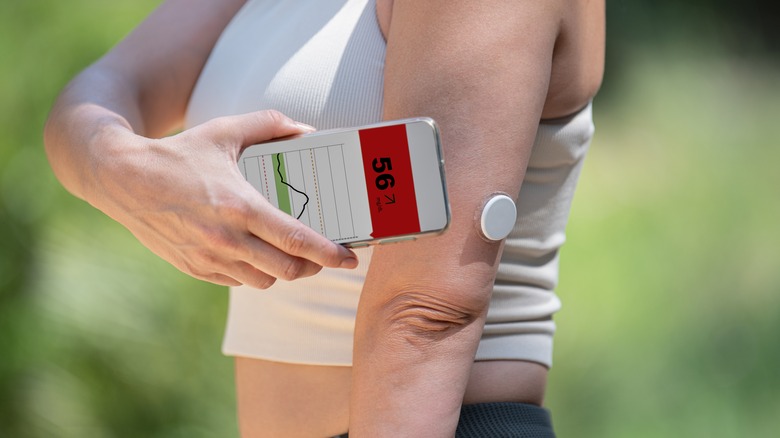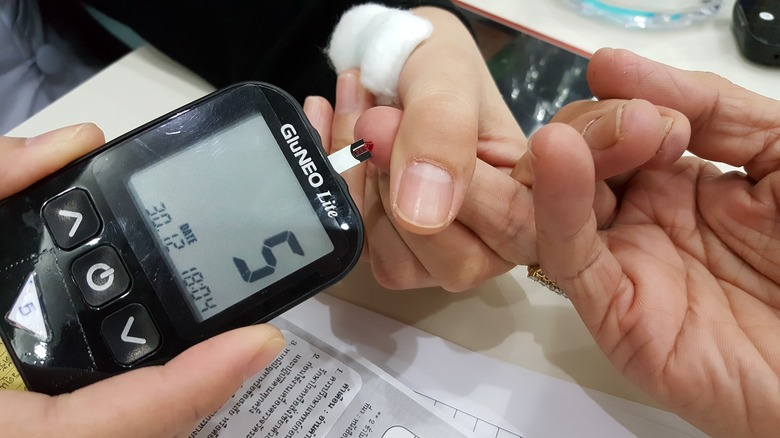What Is Dysglycemia?
Dysglycemia is a condition that results when there are abnormal levels of sugar (glucose) in the blood (via Healthline). It can either be too high (hyperglycemia) or too low (hypoglycemia). Both can lead to serious health problems if left untreated. Hyperglycemia, or high blood sugar, occurs when there is too much glucose in the bloodstream, according to Cleveland Clinic. This can happen for a variety of reasons, including eating more carbohydrates than usual, not getting enough exercise, or being involved in stressful situations. Certain medications, such as steroids or some diuretics, can cause hyperglycemia, as well as some medical conditions like Cushing's syndrome or pancreatitis.
If left untreated, hyperglycemia can lead to serious health problems, such as diabetic ketoacidosis or coma. Diabetic ketoacidosis is a life-threatening condition that occurs when the body starts breaking down fat for energy because it doesn't have enough glucose. This can cause a build-up of acids in the blood called ketones, which can make you very ill. Coma is another potential complication of untreated hyperglycemia that can happen when there is so much glucose in the blood that it starts to poison the brain. The symptoms of hyperglycemia can vary from person to person, but they can include increased thirst, frequent urination, fatigue, and blurred vision. If you have any of these symptoms, it's important to see a doctor right away so that you can be treated.
What to know about Hypoglycemia
Hypoglycemia, or low blood sugar, occurs when there is not enough glucose in the bloodstream (via Mayo Clinic). This can happen for a variety of reasons, including eating less than usual, skipping meals, or exercising more than usual. Drinking alcohol can also cause hypoglycemia, as well as taking certain medications such as insulin or some diabetes pills.
If left untreated, hypoglycemia can lead to serious health problems, such as seizures or coma. Seizures are caused by a sudden drop in blood sugar, which can lead to loss of consciousness and muscle convulsions. Coma is another potential complication of untreated hypoglycemia. It can happen when there is so little glucose in the blood that it starts to poison the brain. The symptoms of hypoglycemia can vary from person to person, but they can include shakiness, sweating, confusion, and fast heartbeat. If you have any of these symptoms, it's important to see a doctor right away so that you can be treated.
How is dysglycemia diagnosed?
Dysglycemia is usually diagnosed with a blood test (via Healthline). Your doctor will likely order a fasting blood sugar test or a casual plasma glucose test. In a fasting blood sugar test, you will be asked to fast (not eat or drink anything) for 8 hours before the test. A sample of your blood will then be taken and tested for glucose levels. A normal fasting blood sugar level is less than 100 mg/dl. In a casual plasma glucose test, a sample of your blood will be taken at any time, regardless of when you last ate.
If either of these tests shows that you have high blood sugar, your doctor may order a follow-up test called an oral glucose tolerance test. In this test, you will be asked to fast for 8 hours before the test. A sample of your blood will then be taken and tested for glucose levels. You will then drink a sugary solution and have your blood sugar levels checked again 2 hours later. If your blood sugar is still high after 2 hours, it's likely that you have diabetes.
How is dysglycemia treated?
The treatment for dysglycemia depends on the underlying cause. If you have diabetes, the treatment will focus on keeping your blood sugar levels under control with diet, exercise, and medication (via WebMD). If you have prediabetes, the treatment will focus on preventing the development of diabetes with diet and exercise. If you have hypoglycemia, the treatment will focus on bringing your blood sugar levels back to normal with food or medication.
The outlook for people with dysglycemia also depends on the underlying cause. If you have diabetes, the goal of treatment is to keep your blood sugar levels under control to prevent complications. With proper treatment, most people with diabetes live long and healthy lives. If you have prediabetes, the goal of treatment is to prevent the development of diabetes. With lifestyle changes and weight loss, most people with prediabetes can prevent the progression to diabetes (via The Centers for Disease Control and Prevention). If you have hypoglycemia, the goal of treatment is to bring your blood sugar levels back to normal.
How to manage your blood sugar levels if you have diabetes
If you have diabetes, the goal of treatment is to keep your blood sugar levels under control. This can be done with diet, exercise, and medication (via Mayo Clinic). A healthy diet for someone with diabetes includes plenty of fruits, vegetables, whole grains, and lean protein. It also limits sugary foods, saturated fats, and sodium. Exercise also helps to lower blood sugar levels by making the body more sensitive to insulin. Aim for at least 30 minutes of moderate exercise on most days of the week. If you take insulin or other diabetes medications, it's important to take them as prescribed. You should also monitor your blood sugar levels at home with a home blood sugar meter. This will help you to see how your diet, exercise, and medication are affecting your blood sugar levels.
If you have prediabetes, the goal of treatment is to prevent the development of diabetes. This can be done with lifestyle changes and weight loss, according to The American Diabetes Association. A healthy diet for someone with prediabetes includes plenty of fruits, vegetables, whole grains, and lean protein. It also limits sugary foods, saturated fats, and sodium. Exercise also helps to prevent the development of diabetes by making the body more sensitive to insulin. If you are overweight or obese, weight loss can also help to prevent the progression to diabetes.
How to manage your blood sugar levels if you don't have diabetes
If you don't have diabetes, there are still things you can do to keep your blood sugar levels in a healthy range. A healthy diet for someone without diabetes includes plenty of fruits, vegetables, whole grains, and lean protein (via Healthline). It also limits sugary foods, saturated fats, and sodium. Exercise also helps to keep blood sugar levels in a healthy range by making the body more sensitive to insulin. Aim for at least 30 minutes of moderate exercise on most days of the week. The CDC recommends 150 minutes of moderate exercise per week (via The CDC). If you are overweight or obese, weight loss can also help to lower blood sugar levels.
If you have any questions about how to keep your blood sugar levels in a healthy range, be sure to talk to your doctor. They will be able to give you more information and help you make the best decisions for your health.





